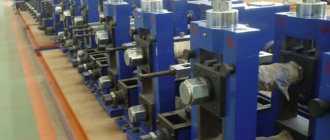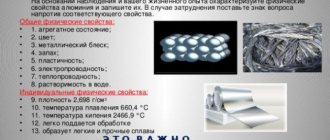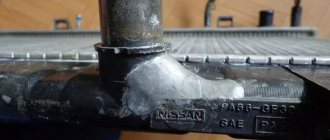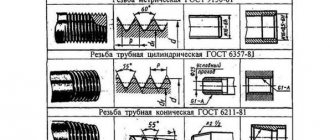Specialists often have to change both the configuration and other geometric parameters of pipe rolling to solve various problems. Most often, to change the shape and size of a tubular product, a technological operation such as flaring is used. It should be borne in mind that this operation is fundamentally different from what is called rolling, and these differences are significant.
The ends of these copper pipes are flared: expanded to a specific shape and prepared for connection
Areas of application
The practical application of pipe flaring has a somewhat specific situation.
This is due to the fact that the method of connecting pipes using flaring is a rather old technological technique, which, with the development of industry, was largely replaced by other types of connections. But a number of specific areas of application of flaring have not found a proper technological replacement and are still used in their unchanged form. As an example, we give the most typical and common areas of application of flaring, namely:
- In the energy industry, in the manufacture of water tube heat exchanger grids to create a strong, sealed connection between copper or brass pipes and the cylindrical holes of a steel tube grid. And also at housing and communal services enterprises for the corresponding repair of these water-tube heat exchangers. Flaring is increasingly used to secure pipes in various boiler equipment such as condensers, steam generators, economizers and oil coolers.
- In the household sector for creating detachable connections from copper tubes during the installation of air conditioning systems. Copper pipes are used to connect the external and internal blocks of the split system, through which the refrigerant circulates.
- In the food industry, in the manufacture of industrial refrigeration chambers, to create reliable detachable connections of copper and brass tubes directly at the installation site of the equipment, allowing it to fit into any room configuration with standard equipment.
- In alternative energy when installing heat pumps, for connecting copper pipes in complete analogy with split systems.
- At automobile industry enterprises in the manufacture of quick-release connections of steel tubes for the hydraulic brake system or copper tubes for the hydraulic clutch system of a car. Flaring and stamping are also used in the manufacture of various cooling radiators for internal combustion engines.
Water supply heating installation services
LLC DESIGN PRESTIGE 8(495)744-67-74
In addition to fast and high-quality repair of heating pipes, we provide professional installation of turnkey heating systems. On our heating page > resant.ru/otoplenie-doma.html < you can view and get acquainted with examples of our work. But to be more precise, it is better to check with an engineer about the cost of work and equipment.
To contact us, use the contact number of DESIGN PRESTIGE LLC 8(495) 744-67-74, which you can call around the clock.
Heating from DESIGN PRESTIGE LLC Type: water here > /otoplenie-dachi.html
note
Our company DESIGN PRESTIGE LLC is part of the non-profit organization ANO INTERREGIONAL BOARD OF FORENSIC EXPERTS. We also provide independent construction technical expertise services.
Heating cost calculation
The cost of repairing heating systems
Cost of installation of water supply
Previous entry Pipe box: decorative made of plastic
Next entry Couplings for polyethylene pipes and connection
Features of the technology
In the modern automotive industry, there are eight types of flaring of copper, brass, aluminum and steel tubes. They are used to create detachable connections for various hydraulic and fuel systems in modern cars. Most types of these flaring are produced industrially on special machines in the factory.
Three types of flaring
But the main three types of flaring are the most common and are used both in the automotive industry and in the installation of various power equipment. These include:
- simple single flaring to a “D” cone, made at an angle of 45 degrees in the form of a single funnel, most hand-held tube flaring tools are suitable for its manufacture;
- double flaring of tubes to an “E” type cone is also performed at an angle of 45 degrees in the form of a single funnel with a double reinforced edge of the tube; a more specialized flaring tool with special nozzles is suitable for this;
- one-time flaring of steel pipes for type “F” fungus is performed with a special eccentric flaring.
Pipe flaring is a rather complicated operation technologically and requires careful preparation. Therefore, to obtain a high-quality connection using flaring, it is necessary to fulfill and observe the following conditions:
- The pipe cut must be perfectly straight,
- the walls of the pipe intended for flaring must have the same thickness over the entire diameter;
- The flaring area must be perfectly flat and smooth, and there must be no traces of residual deformation or cracks.
Purpose of brake pipes
In order to have a clear picture of what brake pipes are needed for and what role they play, you do not need to consider them as a separate element, you need to become familiar with the entire braking system of the car. Thus, having understood the operation of the system as a whole, the task of the tubes will be clear. The braking system, superficially, works in this way: if it is necessary to slow down or brake sharply, the driver presses the corresponding pedal, and the piston located in the master cylinder, under high pressure, begins to drive fluid along special paths.
Braking itself or a complete stop of the car occurs at the moment, at the moment of converting the forces of fluid pressure on the wheel cylinders into the resistance of the brake pads. So, the paths along which the piston drives fluid to the wheels consist of brake pipes and hoses. Failure of any part of the system results in a breakdown of the entire braking system, and consequently, your car becomes unusable.
Tube flaring technology
Tube flaring technology
The technology for flaring pipes can be illustrated by the operation of a hand-held flaring tool, which consists of a base with countersunk holes for the main pipe sizes and a corresponding set of nozzles.
Before starting work, the tube must be cut evenly, so that the cut is strictly perpendicular to the central axis. It is recommended to use pipe cutters specially adapted for this purpose. After this, we process the cut edge of the pipe with a file or cut off a chamfer using a rimmer and thereby remove all burrs from the inner and outer parts of the end.
Next, a tube is inserted into the hole of the base strictly along the diameter and clamped with a strong metal frame so that the edge of the tube protrudes slightly above the plane of the base level.
We take a nozzle corresponding to the hole, which is a steel cylindrical object on one side with a cone-shaped surface and a device for a pressure screw on the other side. Depending on the type of future connection, the flaring nozzle may have a different shape, so we select the surface of the required configuration.
Having installed the nozzle we need, we begin to gradually tighten the screw of the centering rod, pressing the surface of the nozzle onto the tube, gradually pressing it to the edges of the hole in the base. Upon completion of the operation, the rod screw is unscrewed, the base is disassembled and the flared tube is freely removed from the device.
The most important thing is not to forget to put the fitting nut on the tube in advance, otherwise you will have to repeat all the operations in the same sequence one more time.
Tip: as with any processing of metal products, it is recommended to lubricate the flaring area with a small amount of machine oil in advance.
Rolling
Rolling is done on a lathe using special tools. Due to the elasticity of the thin edge of the frame, the pressure on the glass is relatively small, therefore, with proper rolling, optical parts of even small thickness are not deformed and do not receive internal stresses. When rolling, the folded edge of the frame should lie only on the chamfer, and not on the polished surface of the lens. To make the connection waterproof, the rim of the lens is coated with a special putty before installation in the frame.
Rolling is carried out on a lathe or drilling machine using special tools.
Rolling, crimping, embossing and quasi-hydrostatic pressing are used mainly for joining polycrystals of superhard materials to the body. At tool factories, the most widely used method is hot dynamic pressing, used at the Instrument plant (Leningrad), and the method of quasi-hydrostatic pressing. The holder is heated by induction, in a protective atmosphere. The quasi-hydraulic pressing method involves compressing the same part of the holder as during hot dynamic pressing, but without heating. Before crimping, a copper or stainless steel cup is inserted into the holder socket, into which the polycrystal is installed. A second cup is put on the cup, and the holder is placed in a cotlinite chamber and subjected to compression at pressures of up to 8000 MPa. At such pressures, the metal of the holder and cups becomes plastic, flows (hence the name of the method - quasi-hydraulic pressing), envelops the polycrystal and holds it firmly. Conducted at the Sestroretsk Tool Plant named after. However, to fix polycrystals of hexanite R, which are sensitive to overheating, it is more advisable to use the quasi-hydraulic pressing method, since it does not require heating.
Seam rolling and lid sealing ensure complete sealing of the drums. The outer surface of the drum is covered with black varnish, and the bottom is covered with blue paint. Each drum must have the following inscription: name of the plant, name and type of product, batch number, analysis number. Caustic potash can only be stored in undamaged drums.
Rolling of housings is carried out in two operations on a 10-15 ton eccentric press. A rolling stamp is installed on the press.
Rolling of the stone into a screw-frame is carried out on a lathe-clock machine.
Rolling of the composition is carried out on two or three rollers, additional rolling and removal - on one rollers. The gap between the rollers during rolling, re-rolling and removal should be within 1 - 2 mm.
Rolling of the composition can be done on one or several rollers. The rollers of the rollers must be heated to the temperature indicated above and shifted to a gap of 3 - 5 mm. The components are loaded while the rollers are moving in small portions for 5 - 10 minutes. After the formation of a continuous layer that tightly fits the roller, the mass is trimmed with a knife and turned over. At the end of rolling, the plasticized mass in the form of rolls is removed from the rollers, with the exception of the 3-5 kg seed, and transferred to the pre-rolling rollers.
| Scheme of the stamp operation. |
The rolling of the housings is carried out on an eccentric press. A rolling stamp is installed on the press.
Rolling the housings of mercury-zinc elements is one of the most critical operations in the manufacture of current sources for this system. The quality of rolling determines the tightness of the element.
| Types of bending connections.| Connecting parts by pressing in the belts. |
Rolling is most often used to connect cylindrical parts with flat ones.
Rolling is used for pipes and tubular-type parts made of steel, copper, brass and aluminum.
Rolling or seaming is used when securing round lenses, glasses, stone bearings in frames or instrument cases (Fig.
Equipment used
An expander is the simplest and most uncomplicated device for expanding small-diameter tubes, which is
a device with replaceable nozzles that allows the tubes to be flared in one simple operation.
True, you shouldn’t expect any special quality from the expander, and working with it requires a certain skill. The next category of hand tools for flaring are various sets, which usually include:
- two base strips with specially shaped holes corresponding to the main standard sizes of steel and copper pipes, in quantities from 5 to 11 pieces, depending on the configuration and price,
- flaring device with thread for attaching five replaceable dies.
- set of interchangeable stamps.
Often, such kits are equipped with manual rollers designed for cutting aluminum, brass, copper, steel and metal-plastic pipes with a diameter from 3 to 29 mm inclusive.
It is worth noting that, according to numerous reviews on forums on the Internet, users pay attention to the direct dependence of the quality and reliability of such tools on the cost of the sets. As a rule, a cheap tube flaring machine breaks down quickly and is not recommended for use in large volumes of work.
The next category of devices are various types of tube flaring machines. They are distinguished by more reliable and high-quality components, high cost and are intended for professional use.
On the machines, pipe flaring is carried out using an electric, hydraulic or pneumatic drive using torque controllers for complete automation of work processes.
Types of connection of elements
Today, two methods of connecting copper pipes are used: couplings and soldering. The method you choose during the process will completely influence the course of your actions.
When connecting products with couplings, you must adhere to the following procedure:
- You need to thoroughly clean the edges of the pipe.
- A coupling must be placed on the end of the tube.
- After this, the flaring machine must be put into operation. You need to insert the prepared pipe into it and turn the equipment screw until the bending angle reaches 45 degrees.
- After this, the processed product should be taken out of the flaring machine and connected to another element using a coupling.
Experts recommend that beginners and inexperienced home craftsmen use a coupling pipe connection after flaring.
When connecting pipes by soldering, follow these steps:
- Using a special brush, thoroughly clean the edges of the pipe.
- Insert the pipe into the flaring machine, and widen its edges so that you can insert a second pipe into it. In this case, there should be a small gap between the tubes.
- Apply flux to the pipe that is placed inside and insert it into the flared mating pipe. The insertion depth should be equal to the diameter of the tube.
- Heat the junction of two pipes using a gas torch or soldering iron. The solder should melt well and completely remove the gap between the surfaces of the tubes.
- Place the soldered elements on a horizontal surface and wait until they cool down to air temperature. Only after cooling can you work with the soldered pipe.
When choosing a flaring device, consider the diameter of the products you plan to work with. For heating systems, the cross-section range ranges from 32-40 millimeters. And for air conditioning systems, products are used whose diameter does not exceed 16 millimeters. You also need to rely on such criteria as the quality of the resulting socket and the possibility of using replaceable nozzles for different pipe sections.
Specifics of flaring steel and aluminum.
When flaring steel or aluminum tubes, unlike copper and brass pipes, the rolling operation must be carried out slowly, constantly monitoring the condition of the surface, since when excessive pressure is applied, ruptures can occur when the metal is stretched.
This is due to the fact that steel and aluminum tubes have less ductility, so when a fungus or cone is formed, numerous microcracks can form. If there is uncertainty about the sufficient ductility of the material of steel or aluminum tubes, it is recommended to preheat them before flaring, respectively, for steel to 500-600⁰ C, and for aluminum to 200-300⁰ C.
Eccentric flaring machine
The common eccentric tube flaring machine is used to produce quality parts. Among the features of this version, we note:
- Pressure is transmitted when force is applied through a mechanical element. The tip is made of high hardness metal.
- The delivery set includes many different tips, changing which you can get a surface of different shapes.
- The cost of such a mechanism is relatively low. A wide variety of metals can be used in manufacturing, for example, those with high corrosion resistance.
To increase the transmitted force, a long handle is used. It is fixed in a special holder.
How to flare tubes
You need to change a steel or copper tube in your car, and there is no specialized flaring tool available, making it difficult to find or buy one. This is where advice on how to flare a tube with your own hands comes in handy.
Let's get started:
- To begin with, we take two small wooden blocks, selecting the size and thickness so that they can be clamped in a regular vice.
- We clamp the selected bars in a vice and drill a through hole in the center of the seam of their connection with the diameter of the same steel or copper tube that you need to flare.
- Next, on one side of the hole, use a drill of a larger diameter to drill a small cone-shaped recess. All the foundation is ready.
- We fix the tube in a manufactured base made of two wooden blocks and firmly clamp the entire structure in a vice. The tube should rise one or two millimeters above the surface of the bars.
- We take a steel ball from a bearing with a diameter approximately one and a half to two times larger than that of the tube and, with not very strong blows of a hammer, begin the flaring process. If the tube begins to slip in the wooden base, then, if necessary, wrap it with fine sandpaper.
Advice. If the “flared” connection leaks, then to eliminate the leak, you can place a thin lead washer between the tube and the fitting.
If you know your flaring method or have special experience in this matter, share it in the comments block.
Recommendations for implementation
Even if you have never dealt with the flaring process before, you can get a good result the first time. Advice and recommendations from experts will help with this.
- Pipes must be carefully checked before work. Their cross-section should be perfectly round, without burrs, debris or other defects.
- During processing, distortion of the workpieces and the expanding tip must not be allowed. Otherwise, the socket will be asymmetrical, and a reliable connection will no longer be possible.
- In the case of manual processing, the blank is not pressed in, but screwed in. In this case, the force will be evenly distributed and the likelihood of pipe damage will be reduced.
- If the work is performed with an expander, the pipe processing is divided into several stages. Stretching the pipe should be done after the edge has been slightly expanded.
- When using machines with dies, you need to clearly select the hole to match the diameter of the workpiece - the error here should be minimal.
- The outside of the pipe is treated with an abrasive sponge, which will remove dust and other contaminants. If you skip this step, you may encounter the workpiece slipping in the matrix, which will greatly complicate the work.
For an overview of pipe flaring tools, see below.
Instead of an epilogue
An analysis of the modern market has established that it is most dominated by models produced in Asian countries. However, the following trend can be noted, indicating that if a device is not in the budget segment, but is made in Asia, then its quality can be trusted. At the same time, Russian samples are not very popular among domestic buyers due to their low functionality. However, they are able to maintain the quality at the same level. As for Western manufacturers, everything about their samples is good - quality, functionality, and ergonomics. But they are extremely overpriced. From this we can conclude that the best choice may be samples from the middle price segment, produced in the Far East. At the same time, for greater convenience, you should purchase devices whose matrices are capable of working in two number systems at once - both metric and inch.
Rating of the best pipe expanders, flaring tools and pipe flaring tools for 2022
Budget models
3rd place: “AvtoDelo type D.ESAE FISO 4.8 -12.7”
A good set that will come in handy in a garage, auto repair shop, or service station. Quite easy to use, all parts have a maximum service life due to the simplicity of their design. The parts are based on a durable casing base, protected from premature corrosion. The set is well equipped.
| Name | Index |
| Manufacturer country | China |
| Weight, kg | 1 |
| TTX | Works with tubes from 4.8 to 12.7 mm. |
| Price, rubles | 930 |
AutoDelo type D.ESAE FISO 4.8 -12.7
Advantages:
- Five replaceable nozzles in the set;
- Budget price;
- Durable adapter.
Flaws:
- Limited functionality.
2nd place: “7 items Case of Technology 820307”
The kit is specifically designed for flaring brake pipes. The toolkit works great with stainless steel, copper, aluminum and brass. The kit includes a convenient case and a pipe cutter with flaring tool. The knife disc is particularly hard, however, it requires careful cleaning after each use. The vice holds the workpiece securely.
| Name | Index |
| Manufacturer country | Taiwan |
| Weight, kg | 1.34 |
| TTX | Works with tubes from 6 to 15 mm. |
| Price, rubles | 1200 |
7 items Technique Case 820307
Advantages:
- Not a bad package;
- Focus on working with non-ferrous metals;
- Ergonomics at “5+”.
Flaws:
- Inconvenient case.
1st place: “Pipe expander 3pcs AE&T TA-M1001”
The set is positioned as a reliable toolkit for the purpose of slightly increasing the diameter of the pipe. Works only on soft materials and their alloys (aluminum, copper). Connection is only possible with pipes of the same diameter. Can also be used with impact devices. Storage must be carried out only in a lubricated form (solid oil).
| Name | Index |
| Manufacturer country | China |
| Weight, kg | 2.8 |
| TTX | Works with tubes from 29 to 89 mm. |
| Price, rubles | 2500 |
Pipe expander 3pcs AE&T TA-M1001
Advantages:
- Convenient case;
- Variability of pipe diameters;
- Possibility of changing heads.
Flaws:
- Special storage conditions are required.
Middle price segment
3rd place: “Device for flaring MASTAK 102-12001”
A special device for expanding pipes for soldering. Can be used for pipes made of soft materials (copper, aluminum, stainless steel), works in both inch and metric systems. The scope of application is wide - from use in auto repair shops and service stations to work at a professional industrial level. All parts are made of tool steel, plated with chrome, and have oxidized protection.
| Name | Index |
| Manufacturer country | Russia |
| Weight, kg | 0.88 |
| TTX | Works with tubes from 4 to 16 mm. |
| Price, rubles | 3100 |
Flaring device MASTAK 102-12001
Advantages:
- Light weight;
- Adequate price;
- Ease of use.
Flaws:
- There is no storage case (supplied in a plastic bag).
2nd place: “Set for flaring inch pipes FORCE 656”
The kit is designed to work in the inch number system and is adapted for processing aluminum-copper products. Works well on thin steel. The cutter cuts steel tubes well, and the clamp perfectly fixes the workpiece - any slipping is excluded. The set is perfect for home use and quickly pays for itself.
| Name | Index |
| Manufacturer country | Taiwan |
| Weight, kg | 1.46 |
| TTX | Working with 4.75 dm tubes |
| Price, rubles | 3850 |
Inch pipe flaring kit FORCE 656
Advantages:
- Excellent equipment;
- Adequate price-quality ratio;
- Fast payback.
Flaws:
- Work only in the inch number system.
1st place: “NEO tube flaring kit 10 pcs. 02-050"
Set from a high-quality European manufacturer. All working parts are made of heavy-duty materials, the clamps secure the products perfectly, and kinks are not allowed during operation. It has the quality of multifunctionality and versatility, because it is suitable for all common pipe diameters. It is quite easy to store and transport.
| Name | Index |
| Manufacturer country | Poland |
| Weight, kg | 1.58 |
| TTX | Working with tubes 4 – 14 mm |
| Price, rubles | 4800 |
NEO tube flaring set 10 pcs. 02-050
Advantages:
- Versatility;
- High ergonomics;
- High-quality European brand.
Flaws:
- Not identified (for its segment).
Professional samples
3rd place: “Set for cutting and flaring tubes JTC-5633”
Excellent pipe flaring/cutting kit. All devices are made of high-quality alloy steel, are characterized by increased wear resistance, and work on most non-ferrous metals. Adapters available for all common sizes (including 5/16), supplied with a spare blade. It does not wrinkle the edges, the result is very neat.
| Name | Index |
| Manufacturer country | Taiwan |
| Weight, kg | 2.44 |
| TTX | Working with tubes 1/8 – 7/16 dm |
| Price, rubles | 5500 |
JTC-5633 Tube Cutting and Flaring Kit
Advantages:
- Accuracy in cutting;
- High quality manufacturing material;
- Convenient briefcase for storage/transport.
Flaws:
- Not identified (for its segment).
2nd place: “Rolling set MEGEON 51808 k0000025305”
A unique flaring set for any mechanic who is focused on working with cold flaring of tubes made of soft materials. Contains a complete set of tools necessary to perform all rolling steps. There is a scraper for removing burrs from the inner edge, a head with a nozzle operates on the eccentric principle, and both the inch and metric systems are used in the matrix. It will be an excellent purchase not only for service station employees, but also for specialists in the installation of refrigeration and pneumatic equipment.
| Name | Index |
| Manufacturer country | Russia |
| Weight, kg | 2.8 |
| TTX | Working with tubes 4 – 32 mm |
| Price, rubles | 9500 |
Rolling set MEGEON 51808 k0000025305
Advantages:
- Excellent equipment;
- Multifunctionality;
- Light weight.
Flaws:
- High price.
1st place: “Eccentric flaring machine Rothenberger 222401”
Focused on processing copper products only. Simultaneously with performing standard functions, it is capable of making sides with an angle of up to 45 degrees. It is characterized as a professional device and is distinguished by its mobility. The use of a coupling reliably controls the load and prevents the walls from bursting. The matrix has the property of automatic centering, which increases accuracy. Smooth insertion of the cone into the needle template prevents the formation of cracks.
| Name | Index |
| Manufacturer country | Germany |
| Weight, kg | 2.71 |
| TTX | Working with tubes 4 – 18 mm |
| Price, rubles | 21000 |
Eccentric flaring machine Rothenberger 222401
Advantages:
- Availability of eccentric input;
- Increased accuracy;
- Possibility of processing sides.
Flaws:
- The price is too high.
Wise choice of tools
Professional devices from well-known brands are more expensive and can only pay for themselves if they are used commercially. If you need to install refrigeration equipment, air conditioning, or replace a section of the heating or water supply system at the same time in your house, the best and optimal choice will be a budget (not even automatic) mechanical model. It will ensure sufficient quality of pipe processing - with proper skill, the sockets will be obtained with identical walls, without cracks, and with a smooth surface. In any case, it is preferable to buy such devices in specialized construction stores or electronic sites. The device must be supplied with a certificate of conformity and a seller's warranty.











